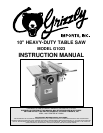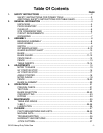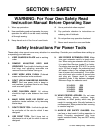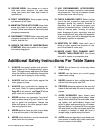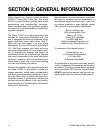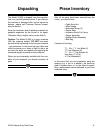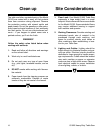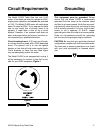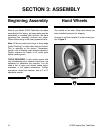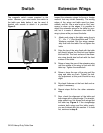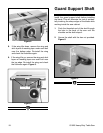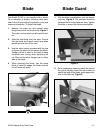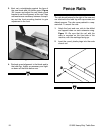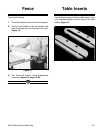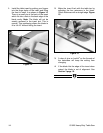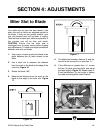
G1023 Heavy-Duty Table Saw -3-
Additional Safety Instructions For Table Saws
1. ALWAYS use guard, splitter and anti-kick-
back fingers on all ''through-sawing'' opera-
tions. Through-sawing operations are those
when the blade cuts completely through the
work- piece as in ripping or cross cutting.
2. ALWAYS hold the work firmly against the
miter gauge or fence.
3. ALWAYS use a push-stick for ripping nar-
row stock. Refer to ripping applications on
Page 23 of this manual, and Page 37 where
push- stick use is covered in detail.
4. NEVER perform any operation ''free-hand''
which means using only your hands to sup-
port or guide the workpiece. Always use
either the fence or the miter gauge to posi-
tion and guide the work.
5. NEVER stand or have any part of your body
in line with the path of the saw blade.
6. NEVER reach behind or over the blade with
either hand for any reason.
7. MOVE the rip fence out of the way when
cross cutting.
8. NEVER use the fence as a cut-off gauge
when cross cutting.
9. NEVER attempt to free a stalled saw blade
without first turning the saw OFF.
10. PROVIDE adequate support to the rear and
sides of the saw table for wide or long work-
pieces.
11. AVOID KICKBACKS (work thrown back
toward you) by keeping blade sharp, keep-
ing rip fence parallel to the saw blade, keep-
ing splitter and anti-kickback fingers and
guard in place and operating, by not releas-
ing work before it is pushed all the way past
the saw blade, and by not ripping work that
is twisted or warped or does not have a
straight edge to guide along the fence.
12. AVOID awkward operations and hand posi-
tions where a sudden slip could cause your
hand to move into the blade.
17. USE RECOMMENDED ACCESSORIES.
Consult the owner’s manual for recommend-
ed accessories. The use of improper acces-
sories may cause risk of injury.
18. CHECK DAMAGED PARTS. Before further
use of the tool, a guard or other part that is
damaged should be carefully checked to
determine that it will operate properly and
perform its intended function - check for align-
ment of moving parts, binding of moving
parts, breakage of parts, mounting, and any
other conditions that may affect its operation.
A guard or other part that is damaged should
be properly repaired or replaced.
19. DIRECTION OF FEED. Feed work into a
blade or cutter against the direction of rota-
tion of the blade or cutter only.
20. NEVER LEAVE TOOL RUNNING UNAT-
TENDED. TURN POWER OFF. Don’t leave
tool until it comes to a complete stop.
12. SECURE WORK. Use clamps or a vise to
hold work when practical. It’s safer than
using your hand and frees both hands to
operate tool.
13. DON’T OVERREACH. Keep proper footing
and balance at all times.
14. MAINTAIN TOOLS WITH CARE. Keep tools
sharp and clean for best and safest perfor-
mance. Follow instructions for lubricating and
changing accessories.
15. DISCONNECT TOOLS before servicing and
changing accessories, such as blades, bits,
cutters, and the like.
16. REDUCE THE RISK OF UNINTENTIONAL
STARTING. Make sure switch is in off posi-
tion before plugging in.



